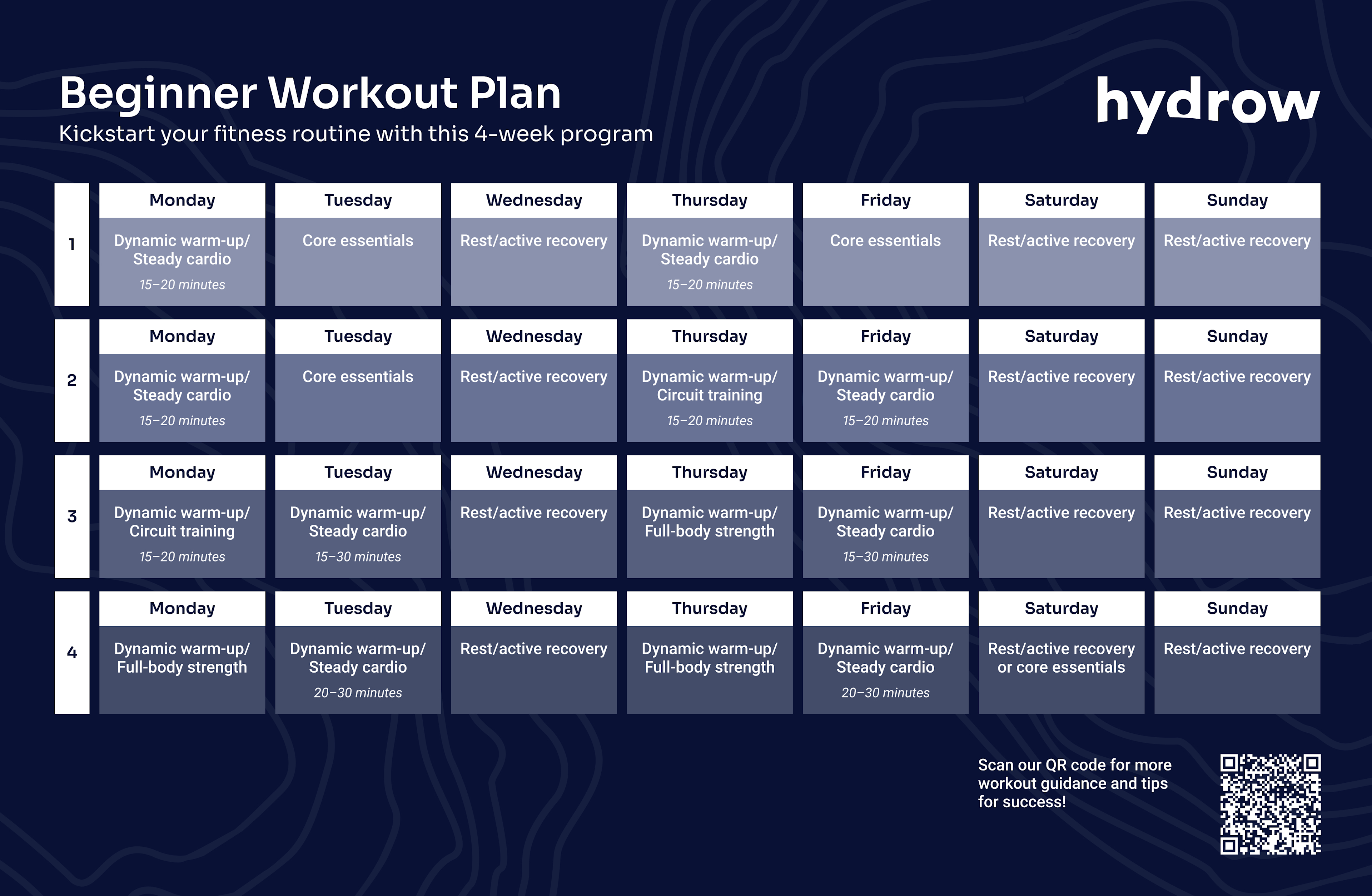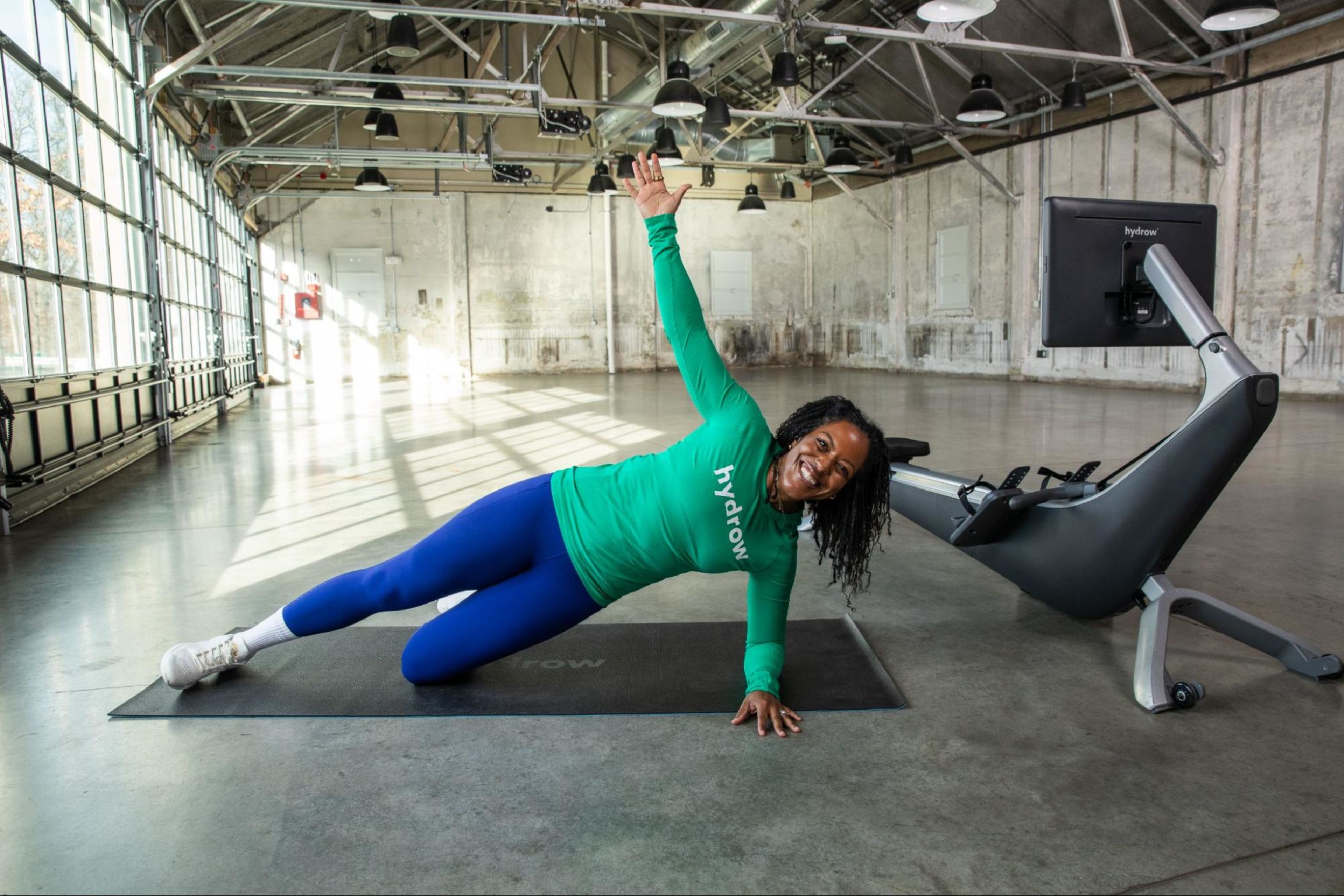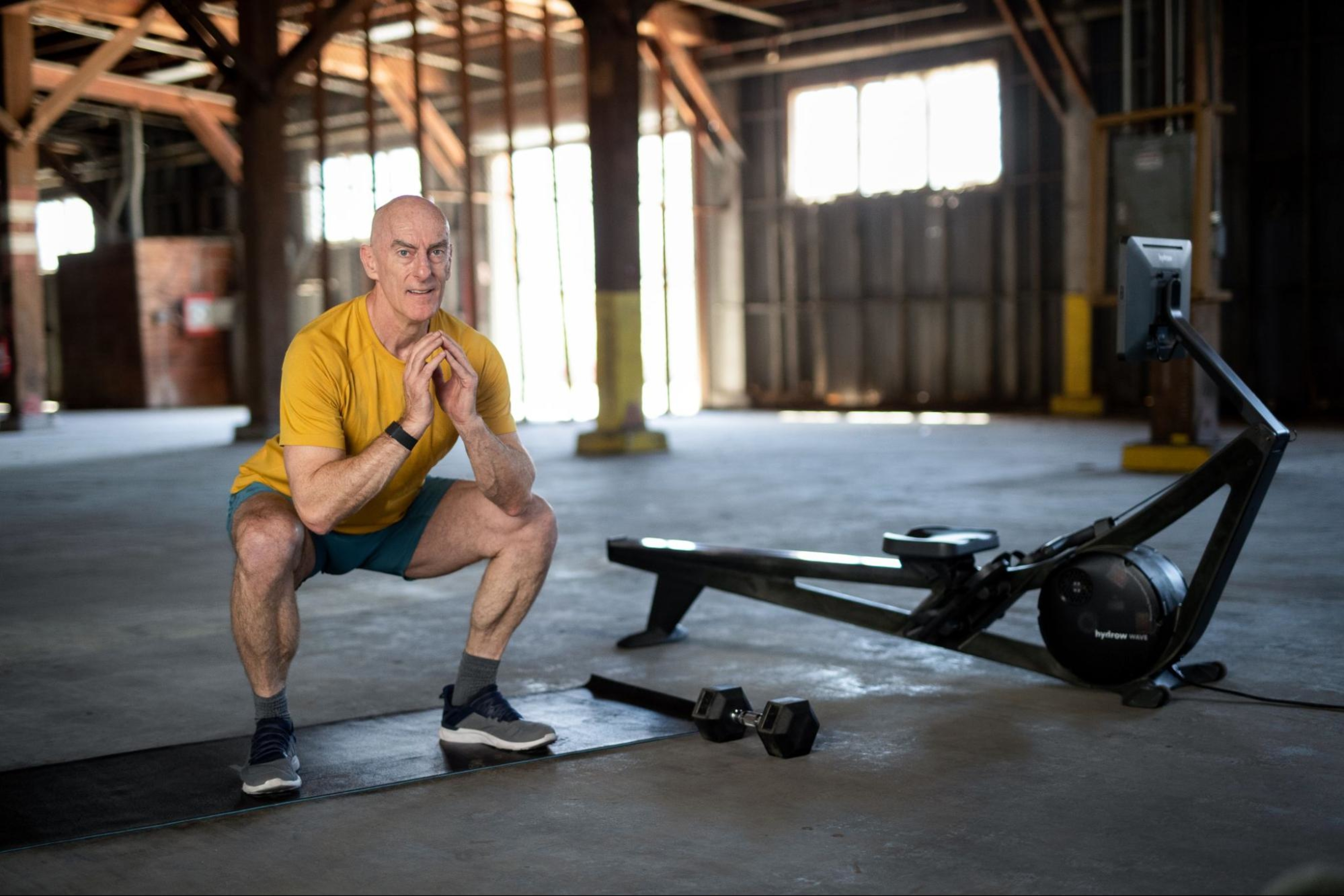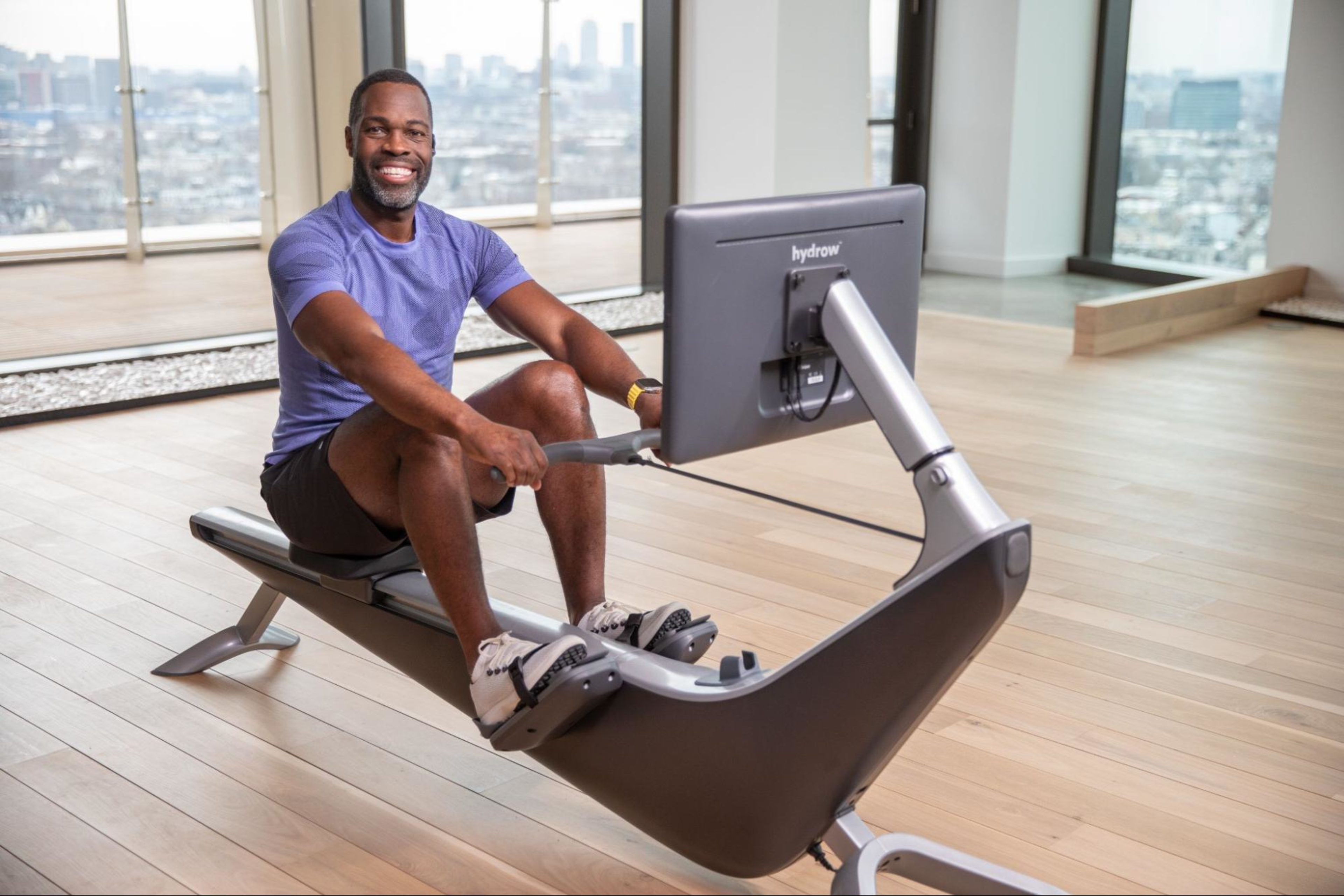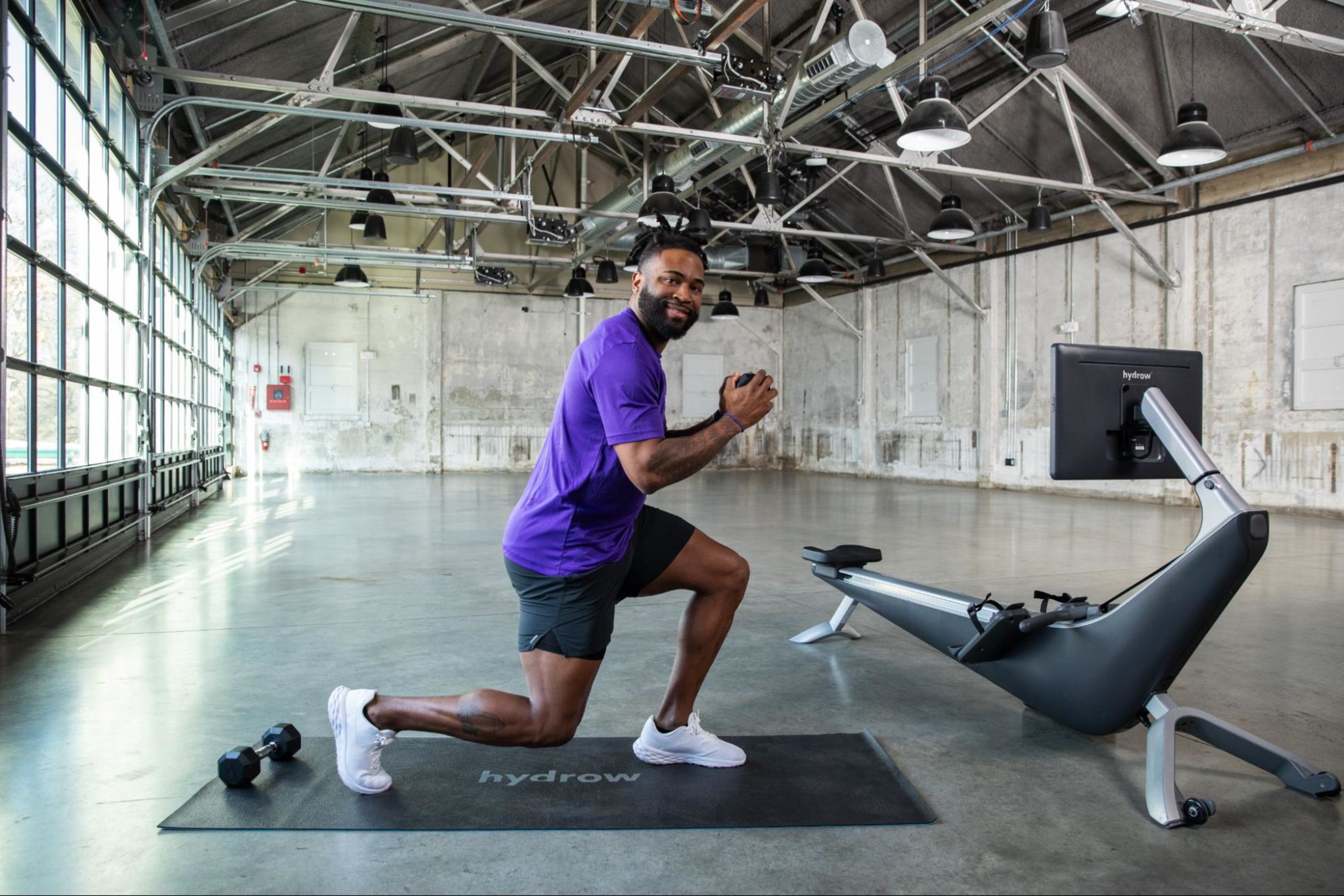4-Week Workout Plan for Beginners: Download This Workout Plan to Kickstart Your Fitness Routine

Starting a fitness routine can feel overwhelming—especially if you’re unsure where to begin. How do you find workouts you enjoy? How much exercise is too much? And how do you make progress without risking injury by pushing yourself too hard too fast?
Designed specifically for beginners, this four-week workout plan can help you ease into exercise with a balanced mix of cardio, strength training, and more. You’ll get clear, easy-to-follow guidance so you won’t feel lost or discouraged, along with a steady progression that allows you to start slow and build confidence week by week.
By the end of these four weeks, you’ll not only feel stronger and more energized—you’ll also have a solid foundation to keep going.
Let’s get started!
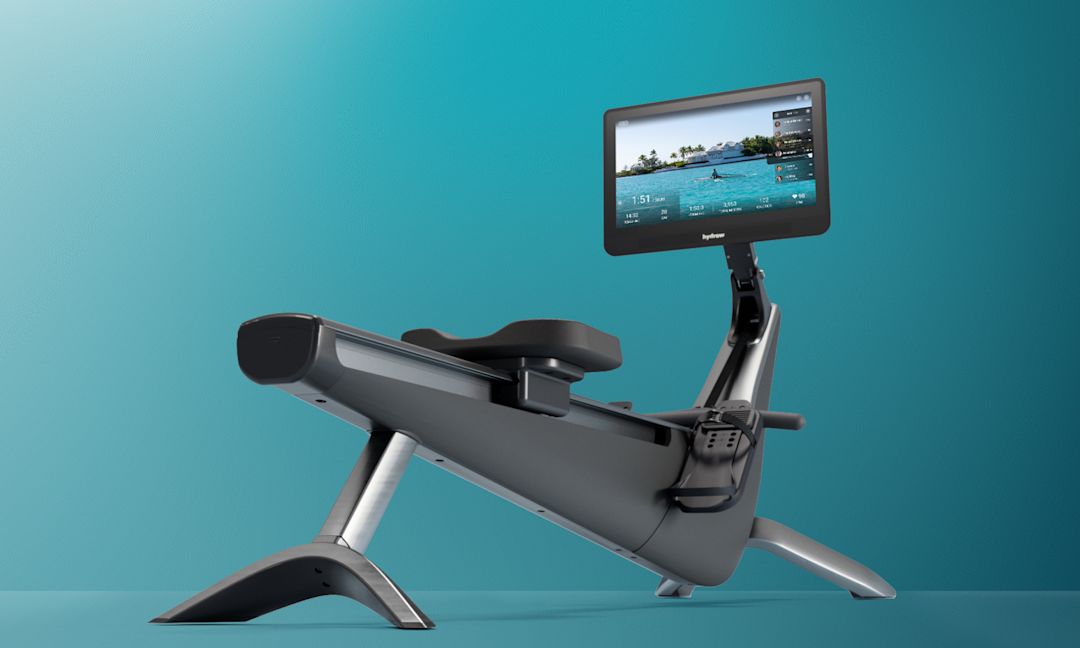
Holiday savings are here
Bring home our award-winning rowers at the best prices of the year.
Your 4-week workout plan for beginners: Quick view
Please note that this is an example of how you could lay out your fitness program by exercising four times a week. However, this plan can easily be reworked to align with the days of the week that are convenient for your specific schedule.
The key here is to plan ahead and stick to that plan until you have integrated fitness habits into your regular routine. We recommend taking time at the beginning of each week to carve out your daily workout window—whether that changes week to week or is always a consistent day or time of day (such as waking up before work or working out on your lunch break).
Whatever you choose, create a plan that fits into your daily and weekly demands. This will create the greatest chance of success at fulfilling your fitness goals.
4-week beginner-friendly workout plan: Week 1
Time to get moving! Here is your schedule for the week:
Monday | Tuesday | Wednesday | Thursday | Friday | Saturday | Sunday |
Five-minute dynamic warm-up and 15–20 minutes of steady cardio | Core essentials | Rest/active recovery | Five-minute dynamic warm-up and 15–20 minutes of steady cardio | Core essentials | Rest/active recovery | Rest/active recovery |
This week is about committing to two solid cardio sessions and two strength sessions. You’ll also have ample time to recover for these workouts with the inclusion of rest days/active recovery days.
5-minute dynamic warm-up and 15–20 minutes of steady cardio
Dynamic warm-up
Before you dive into your cardio workout, start with a dynamic warm-up, a series of controlled, active movements that works through your body’s full range of motion to prepare your body for physical activity. Ideally, these movements should mimic the activity you are about to do, helping to increase blood flow, improve joint mobility, and activate your muscles.
Here is a series of dynamic warm-up exercises to get you ready for your workout:
Hip circles:
Stand with feet hip-width apart.
Place hands on hips.
Make large circular movements with your hips in one direction.
After 10–15 circles, switch directions.
Knee-ups:
Stand tall with feet hip-width apart.
Lift your right knee towards your chest.
Lower it back down and repeat with the left knee.
Alternate knee lifts for 30 seconds.
Butt kicks:
Stand with feet hip-width apart.
Alternate kicking your heels toward your glutes in a controlled movement.
Keep your core engaged and repeat for 30 seconds.
Standing clamshell:
Stand with feet shoulder-width apart.
Turn your right knee outward to the side, keeping your foot on the ground.
Return to the starting position and repeat with the left leg.
Alternate for 10–15 reps each side.
Torso swing:
Stand with feet shoulder-width apart.
Swing your arms gently from side to side while rotating your torso.
Keep your hips stable and repeat for 30 seconds.
Arm circles:
Stand tall with arms extended out to the sides.
Make small circles with your arms in one direction.
After 10-15 seconds, switch directions.
Repeat for 30 seconds total.
If you have a bit more time, you can also follow this 10-minute dynamic warm-up video:
Steady cardio workout
The overall goal of these steady cardio sessions is to improve your cardiovascular endurance. This type of exercise works on improving the capacity of your heart, lungs, and vascular system, as well as your muscular endurance. Over time, this will help contribute to better stamina and reduced fatigue levels while performing everyday activities.
Choose a cardio activity that you enjoy—such as walking, swimming, running, biking, jumping rope, or rowing—and work out for 15 to 20 minutes. You’ll want to aim to hit an exertion level that is above your normal “walk to the car” pace to encourage an increase in your heart rate and breathing (a less fancy way of saying an increase in the intake of oxygen).
However, your steady cardio workout should be at an intensity that you can sustain for a longer period of time while carrying on a conversation.
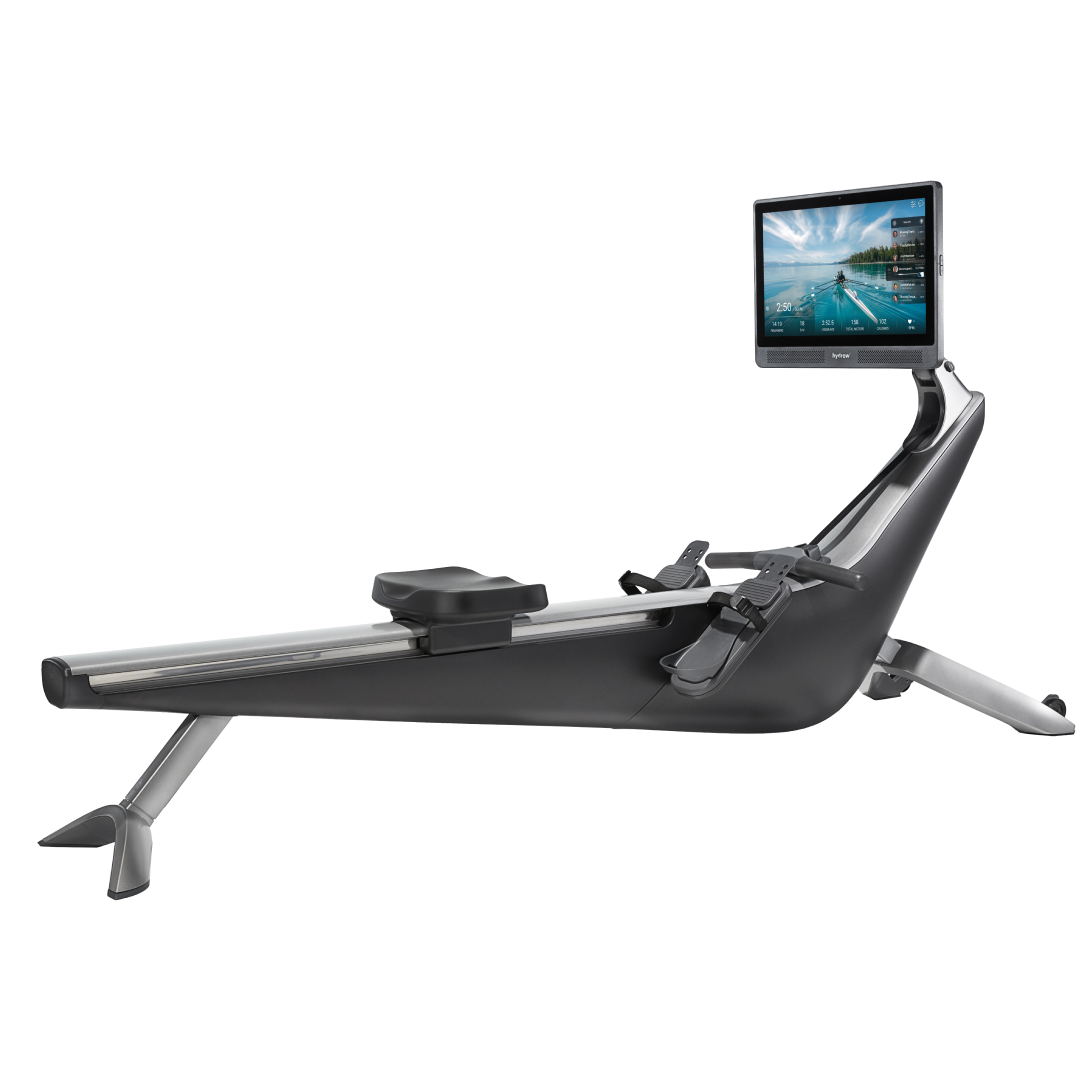
Cardio and strength, combined
Burn calories and build muscle with steady, natural movements.
Core essentials
A strong core is the foundation to all power. Quite often, the core is mistaken for solely the abdominal muscles—how often have you seen someone flaunting their six-pack and bragging about how strong they are? In reality, the abs are only one part of what makes a strong core.
A strong core includes your glutes, abductors, pelvic floor muscles, lower-back muscles, hip flexor muscles, and abdominal muscles. Having a strong core helps improve your overall balance and stability, as well as improve your posture and protect you from falling and other potential injuries. It will also help improve your efficiency in everyday activities, such as lifting heavy grocery bags, or walking up or down staircases or lugging bags of soil to the garden.
Once you have trained yourself to engage your core muscles, you can further build your strength. These core moves will establish a foundation that will enable you to unleash your ultimate power.
Here is the core essential’s workout routine you can follow. For each exercise, you’ll do three sets of 10–15 reps.
1. High knees
How to do high knees:
Stand tall, arms bent at a 90-degree angle, elbows at sides, and palms facing down.
Lift each knee high to touch your palm as you ‘run’ in place aiming to keep upright with the body (resist the urge to break at the waist)
High knees modifications:
Level down: If you’re having trouble with this exercise, you can use a chair or counter to help with your balance.
Level up: If you want to challenge yourself, tie a resistance band into a loop or use a circular resistance band around your feet. Feel the resistance as you lift your knee, with one end of the band under your supporting leg and the other end lifted with your raised leg.
2. Plank
How to do a plank:
Hold a push-up position with your body in a straight line from head to heels.
Keep your abs tight and hold the position for as long as possible up to 1’, gradually increasing your hold time to build endurance.
Plank modifications:
Level down: For an easier start, use a chair or counter instead of doing a plank on the floor, or do a plank on your knees instead of your toes.
Level up: For a challenge, bring your feet closer together or balance on one leg without letting your hips drop.
3. Glute bridge
How to do glute bridges:
Lie on your back with legs bent at 90 degrees and feet flat on the floor.
Lift your hips and back off the floor, forming a straight line from shoulders to knees.
Hold for five to 10 seconds. Then repeat.
Glute bridge modifications:
Level down: To make glute bridges easier, complete a smaller lift of the hips to create a gap between the floor and your glutes.
Level up: For more of a challenge, you can try a one-legged glute bridge.
4. Bird-dog
How to do bird-dogs:
Start on all fours.
Extend one arm and the opposite leg straight out while keeping your core tight, keep back straight. Avoid a dip in the hips.
Return to the starting position and switch sides.
Bird-dog modifications:
Level down: For an easier exercise, lift your arms and legs independently.
Level up: Looking for a challenge? Add a resistance band! Hold one end in your hand and wrap the other around the opposite foot, and you’ll feel the resistance when raised from the ground.
5. Bicycle crunch
How to do bicycle crunches:
Lie face up, lift legs and bend knees 90 degrees with feet on the floor.
Place your hands behind your head with elbows pointing to the sides.
Lift shoulders off the floor using your abs.
Raise your left leg off the floor, bringing the 90 degree knee bend over the hips. Bring your right elbow to your left knee. Be sure the movement is coming from the torso versus the arm/elbow.
Return to the starting position and repeat with the other side.
Continue to alternate the movement.
Bicycle crunch modifications:
Level down: For a more accessible exercise, lift the arms and legs independently.
Level up: Kick your bicycle kicks up a notch by keeping your feet off the ground with your knees bent at a 90-degree angle and/or extending the opposing leg.
6. Lying hip abductions
How to do lying hip abductions:
Lie on your right side with legs straight, left foot resting on the ground.
Lift your left leg up, keeping hips stable.
Return to the starting position and repeat.
Switch sides and repeat with the right leg.
Lying hip abductions modifications:
Level down: For an easier exercise, do a smaller lift off the ground.
Level up: Challenge yourself by wrapping a resistance band around both ankles.
7. Russian twists
How to do Russian twists:
Sit with legs straight, leaning back on your butt.
Bend knees, raising feet off the floor, forming a “V” shape with thighs and torso.
Your back should be at a 45-degree angle to the floor.
Cross arms in front of your chest.
Engage your core to rotate right, return to center, and twist to the left.
Russian twist modifications:
Level down: For an easier exercise, keep your feet planted on the ground.
Level up: Challenge yourself by doing each twist while holding onto a weight, such as a dumbbell, medicine ball, or kettlebell.
8. Bear crawl
How to do bear crawls:
Get on all fours.
Lift your knees a few inches off the ground by pressing into toes and hands.
Keep a flat back, arms shoulder-width apart, and legs hip-width apart.
Move your right hand and left foot forward, then your left hand and right foot forward for one rep.
Reverse the movement.
Repeat the sequence.
Bear crawl modifications:
Level down: You can adapt this exercise by just lifting your knees off the floor without crawling.
Level up: Kick this workout up a notch by adding forward, backward, and lateral movement, or moving in a circular motion.
Rest/active recovery days
Active recovery refers to engaging in low-intensity physical activity or on rest days. It can take many forms—such as a light walk or yoga session—and is a great way to keep your body moving without putting additional stress on your fatigued muscles.
When deciding whether to take a rest day or engage in active recovery, it’s important to take cues from your body. Would you benefit from a rest day, or would your mind and body prefer to do a light workout?
Here are some additional ideas for active recovery exercises to get you started:
Gentle yoga sessions
Low-intensity cycling
Low-intensity rowing
Walking and light jogging
Resistance band exercises
Gentle Pilates
Dynamic stretching
Mobility drills
4-week beginner-friendly workout plan: Week 2
This week, you’ll continue to ingrain a new habit into your regular routine—consistency for the win! Your workouts this week will help you keep building your endurance through steady cardio sessions and strengthening your core:
Monday | Tuesday | Wednesday | Thursday | Friday | Saturday | Sunday |
Five-minute dynamic warm-up and 15–20 minutes of steady cardio | Core essentials | Rest/active recovery | Five-minute dynamic workout and 15–20 minutes of circuit training | Five-minute dynamic warm-up and 15–20 minutes of steady cardio | Rest/active recovery | Rest/active recovery |
Lock into the sessions by kicking off the week similar to the first week, with your steady cardio and core essentials workouts. Later in the week, a new style of workout will be introduced: circuit training! This is a great workout that will still primarily focus on building your core muscles, yet in a manner that keeps you moving so your heart rate will stay elevated. Let’s add a little spice to your core essentials by putting many of the exercises into a circuit-style workout:
Circuit training exercises
Set your timer for 15 to 20 minutes, then complete each exercise for 30 seconds each before moving to the next one.
1. High knees
How to do high knees:
Stand tall, arms bent at a 90-degree angle, elbows at sides, and palms facing down.
Lift each knee high to touch your palm as you run in place at maximum speed.
High knees modifications:
Level down: If you’re having trouble with this exercise, you can use a chair or counter to help with your balance.
Level up: If you want to challenge yourself, tie a resistance band into a loop or use a circular resistance band around your feet. Feel the resistance as you lift your knee, with one end of the band under your supporting leg and the other end lifted with your raised leg.
2. Jumping jacks
How to do jumping jacks:
Stand with feet together, arms at sides.
Jump while spreading arms and legs, landing softly.
Jump while returning arms and legs to their original position.
Land softly and repeat.
You can make this workout easier by stepping to one side, back to center, then the other side.
3. Plank
How to do a plank:
Hold a push-up position with your body in a straight line from head to heels.
Keep your abs tight and hold the position.
Plank modifications:
Level down: For an easier start, use a chair or counter instead of doing a plank on the floor, or do a plank on your knees instead of your toes.
Level up: For a challenge, bring your feet closer together or balance on one leg without dropping in the middle.

Explore Hydrow’s library of Circuit Training workouts from around the world.
4. Jump forward/back/side/side
How to do this exercise: Jump forward, backwards, and to each side, creating a T shape. You can reduce the intensity of this workout by stepping instead of jumping.
5. Glute bridge
How to do glute bridges:
Lie on your back with legs bent at 90 degrees and feet flat on the floor.
Lift your hips and back off the floor, forming a straight line from shoulders to knees.
Hold for five to 10 seconds.
Glute bridge modifications:
Level down: To make glute bridges easier, complete a smaller lift of the hips to create a gap between the floor and your glutes.
Level up: For more of a challenge, you can try a one-legged glute bridge.
5. Burpees
How to do a burpee:
From a standing position, drop into a squat.
Bring hands to the floor and kick your feet back into a plank.
Perform a push-up.
Jump your feet back to your hands.
Leap into the air, completing a vertical jump.
For an easier workout, just reach up, reach down, step backwards, and step forwards one leg at a time to or from the plank position.
6. Bird-dog
How to do bird-dogs:
Start on all fours.
Extend one arm and the opposite leg straight out while keeping your core tight and your back flat.
Return to the starting position and switch sides.
Bird-dog modifications:
Level down: For an easier exercise, lift your arms and legs independently.
Level up: Looking for a challenge? Add a resistance band! Hold one end in your hand and wrap the other around the opposite foot, and you’ll feel the resistance when raising from the ground.
7. Jumping jacks
Repeat the exercise above, modifying if needed.
8. Bicycle crunch
How to do bicycle crunches:
Lie face-, lift your legs and bend your knees 90 degrees with your feet on the floor.
Place your hands behind your head with your elbows pointing to the sides.
Lift your shoulders off the floor using your abs.
Raise your left leg off the floor, bringing the 90-degree knee bend over the hips. Bring your right elbow to your left knee. Be sure the movement is coming from the torso versus the arm/elbow.
Return to the starting position and repeat with the other side.
Continue to alternate the movement.
Bicycle crunch modifications:
Level down: For a more accessible exercise, lift the arms and legs independently.
Level up: Kick your bicycle kicks up a notch by keeping your feet off the ground with your knees bent at a 90-degree angle and/or extending the opposing leg.
9. Jump forward/back/side/side
Repeat the exercise above, jumping forwards, backwards, and to either side in a T-shape.
10. Lying hip abductions
How to do lying hip abductions:
Lie on your right side with legs straight, left foot resting on the ground.
Lift your left leg up, keeping hips stable.
Return to the starting position and repeat.
Switch sides and repeat with the right leg.
Lying hip abductions modifications:
Level down: For an easier exercise, do a smaller lift off the ground.
Level up: Challenge yourself by wrapping a resistance band around both ankles.
11. Burpees
Repeat the burpees exercise from above, modifying if needed.
12. Russian twists
How to do Russian twists:
Sit with legs straight, leaning back on your butt.
Bend knees, raising feet off the floor, forming a “V” shape with thighs and torso.
Your back should be at a 45-degree angle to the floor.
Cross arms in front of your chest.
Engage your core to rotate right, return to center, and twist to the left.
Russian twist modifications:
Level down: For an easier exercise, keep your feet planted on the ground.
Level up: Challenge yourself by doing each twist while holding onto a weight, such as a dumbbell, medicine ball, or kettlebell.
8. Bear crawl
How to do bear crawls:
Get on all fours.
Lift your knees a few inches off the ground.
Keep a flat back, arms shoulder-width apart, and legs hip-width apart.
Move your right hand and left foot forward, then your left hand and right foot forward for one rep.
Reverse the movement.
Repeat the sequence.
Bear crawl modifications:
Level down: You can adapt this exercise by just lifting your knees off the floor without crawling.
Level up: Kick this workout up a notch by adding forward, backward, and lateral movement, or moving in a circular motion.

Explore Hydrow’s library of 5,000+ rowing, circuit training, yoga, Pilates, and mobility workouts.
Rest/active recovery
When it comes to your rest/active recovery days, once again listen to your body. If you are feeling good, call a friend and go for a walk in your neighborhood. If you are feeling tired, then unwind and read a book or watch your favorite show. Or, if you have an especially busy week, embrace that you committed to exercising four times a week—box ticked!
4-week beginner-friendly workout plan: Week 3
Let’s keep the momentum going into the third week of this program, with a continuous focus on building overall endurance and strength. You’re on a roll, so keep it rollin’ with this workout schedule:
Monday | Tuesday | Wednesday | Thursday | Friday | Saturday | Sunday |
Five-minute dynamic workout and 15–20 minutes of circuit training | Five-minute dynamic warm-up and 15–30 minutes of steady cardio | Rest/active recovery | Five-minute dynamic warm-up and full-body strength training workout | Five-minute dynamic warm-up and 15–30 minutes of steady cardio | Rest/active recovery | Rest/active recovery |
This week, you’ll have the opportunity to step up your cardio sessions or keep them status quo—either way, you are still making progress! Feel how these small steps keep you moving toward big wins. You’ll also revisit the circuit training workout from last week.
New to this week’s plan is a full-body strength training session that will build on the process of engaging your core and evolve into more diverse exercises that integrate all aspects of your body.
Steady cardio sessions
If you’re feeling like your steady cardio sessions are getting easier over time, we recommend upping your intensity for one of your two cardio sessions this week. There are two different ways you can do this: increase your duration or your pace.
Increase the duration of your cardio exercise of choice for an extra five to 15 minutes.
Increase your pace, completing one minute at your steady pace then another minute at an increased pace. This change in pace leads to an increased heartbeat and breathing, making it harder to speak freely (for instance, you might only be able to say one sentence at a time before you need to just focus on your breath). Continue to alternate between these intensities until you have completed the full workout.

Did you know?
Over 90% of Hydrow members are still active one year later.
Full-body strength session
Don’t forget that the starting point of all strength exercises should involve engaging your core before you execute the new exercise (just like you practiced in core essentials!). This will help you safely dive into these functional exercises that will strengthen your legs, back, chest, and arms.
Please note that these exercises will require a resistance band or dumbbells. If you don’t have weights, you can use kettlebells, a filled milk jug, or canned goods—feel free to get creative!
This workout involves working through five pairs of exercises. Starting with Pair 1, you’ll do two sets of 8–10 reps, alternating between the exercises before you move down the list onto the other pairs.
Pair 1: Squats and bent-over rows
How to do squats:
Stand with feet shoulder-width apart.
Lower your body by bending your knees and hips. Keep your chest up.
Return to standing.
How to do bent-over rows:
Start standing with your feet shoulder-width apart and a dumbbell (or water bottle) in each hand by your sides, palms facing each other, with a slight bend in your knees.
Hinge from the hips until you’re in a comfortable position (ideally at 45 degrees or more).
While maintaining a long spine, let your weights hang in front of you, wrist under shoulders.
Squeeze your shoulder blades together to pull the weights toward your chest, keeping your elbows close to your ribs. Pause here briefly.
Slowly and with control, lower the weights back down to the starting position.
Pair 2: Romanian deadlifts and bench presses
How to do Romanian deadlifts:
Begin by standing upright with your feet positioned under your hips.
Hold weights in both hands, keeping them by your sides.
Slightly bend your knees, engage your core, and hinge at your hips.
Push your hips backward while maintaining your core engagement. Arms move down legs. Continue until you feel a gentle stretch in your hamstrings.
To complete the rep, squeeze your glutes and return to the upright standing position.
How to do bench presses:
Lie down on a flat bench (or floor), feet flat on the floor.
Hold dumbbells straight above you, with your wrists in line with your shoulders.
Lower the dumbbells slowly to your chest by bending your arms to 90 degrees.
Press up until your arms are straight.
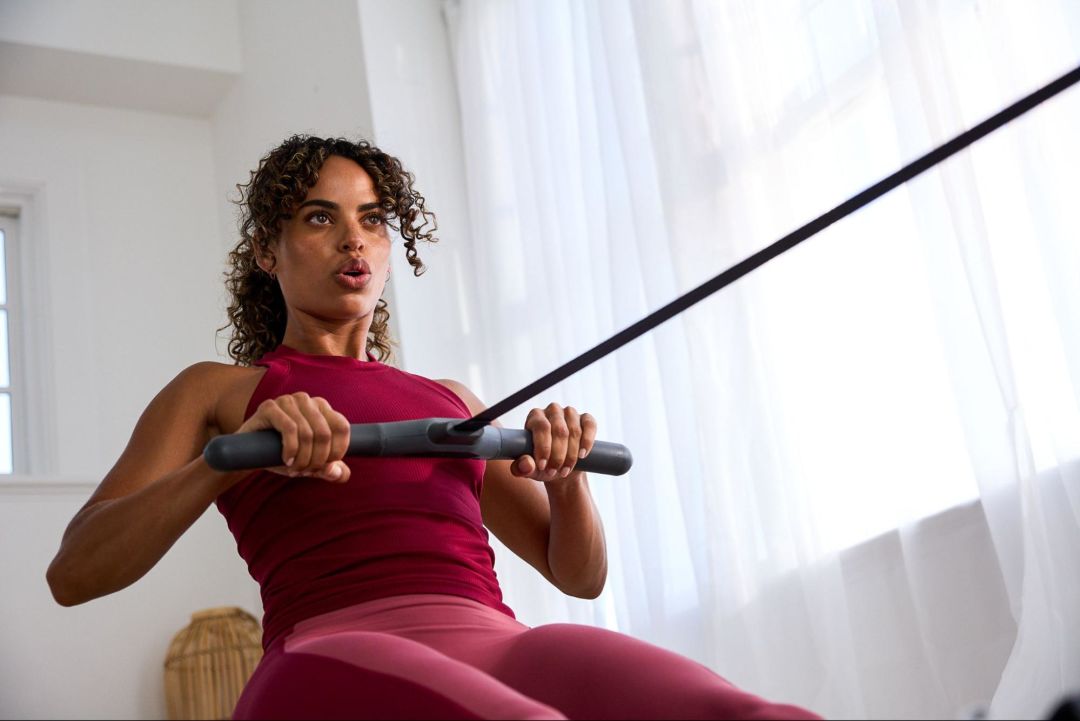
Efficiency for the win.
Work 86% of your muscles in just 20 minutes of rowing with Hydrow.
Pair 3: Step-ups and overhead presses
How to do step-ups:
Stand in front of a staircase at home or an aerobics step or box at the gym.
Step your right foot up onto your surface of choice, ensuring your full foot is on the surface.
Press through your right heel to lift your whole body up and stand fully on the step.
Step your left foot down onto the floor.
Return your right foot to the floor.
Continue for 8–10 reps, then switch sides.
How to do overhead presses:
Start standing tall with your feet planted shoulder-width apart holding a dumbbell (or water bottle) in each hand in front of your shoulders at shoulder height, palms facing forwards.
Press the weights directly over your head without locking out your elbows. The weights should almost touch each other above you.
Slowly and with control, lower the weights back down to your shoulders.
Pair 4: Bicep curls and triceps extensions
How to do bicep curls:
Start standing tall, with your feet planted shoulder-width apart, holding a weight in each hand by your sides, palms facing upwards.
Engage your core and squeeze your arm muscles as you curl the weights toward your shoulders. Keep your elbows close to your body and stationary, as the movement should be from the elbow down.
Slowly and with control, lower the weights back down to the starting position.
How to do triceps extensions:
Start standing tall with your feet planted shoulder-width apart holding a single weight with both hands over your head.
Keeping your upper arms steady and close to your ears, bend your elbows to lower the weight behind your head.
Press the weight back up to the starting position.
Pair 5: Bird-dogs and side planks
How to do bird-dogs:
Start on all fours.
Extend one arm and the opposite leg straight out while keeping your core tight.
Return to the starting position and switch sides.
How to do side planks:
Lie on your left side, with your elbow under the shoulder at a 90-degree angle, keeping the forearm flat on the floor.
Stack your right leg on the left, forming a straight line from head to toes.
Engage core and keep your head forward.
Hold for as long as possible.
Switch sides.
4-week beginner-friendly workout plan: Week 4
Nothing new here! This week, you are simply consolidating all that you have learned over the past four weeks. This final week of the program includes two full-body strength sessions and two cardio sessions. If you are feeling like adding in a fifth workout, revisit the core essentials workout. Here’s your schedule:
Monday | Tuesday | Wednesday | Thursday | Friday | Saturday | Sunday |
Five-minute dynamic warm-up and full-body strength training workout | Five-minute dynamic warm-up and 20–30 minutes of steady cardio | Rest/active recovery | Five-minute dynamic warm-up and full-body strength training workout | Five-minute dynamic warm-up and 20–30 minutes of steady cardio | Rest/active recovery or core essentials | Rest/active recovery |
Amazingly, as you have moved through these past few weeks, you not only learned new exercises that improve your physical well-being, but also exercises that boost your mental well-being! As you learn new things, you also open the door to learning more about yourself. What exactly are you feeling? Perhaps a mixed bag of emotions?
As you progress through the final week, reflect on this program and the positive steps you have made in such a short period of time. There is nothing new added to this program the final week—just the opportunity to really reinforce and solidify the movements you have learned over the course of the past few weeks. We hope you’re feeling a sense of pride and achievement, as well as motivation to continue on your fitness journey.
If you’re looking for more ways to mix up your workout routine, be sure to check out Hydrow. Rowing activates 86% of your muscles with every stroke, making it one of the most efficient ways to build total-body strength. In just 20 minutes on a rowing machine, you can get a full-body workout that boosts energy, builds endurance, and helps you move better—on and off the rower.
And with Hydrow, it’s easier than ever to stay consistent. No commute. No waiting for machines. Just expert-led workouts you can do from home, whenever it works for you. Choose from rowing, strength training, mobility, yoga, Pilates, and circuit training workouts, all designed to help you move better and feel stronger, long-term.
Our workouts are filmed on location in stunning waterways around the world and led by world-class Athletes who coach you through every stroke and rep. And with over 5,000 workouts ranging from beginner to advanced, it’s easy to keep progressing no matter your level.
Every movement adds up. Start building strength that lasts with Hydrow.
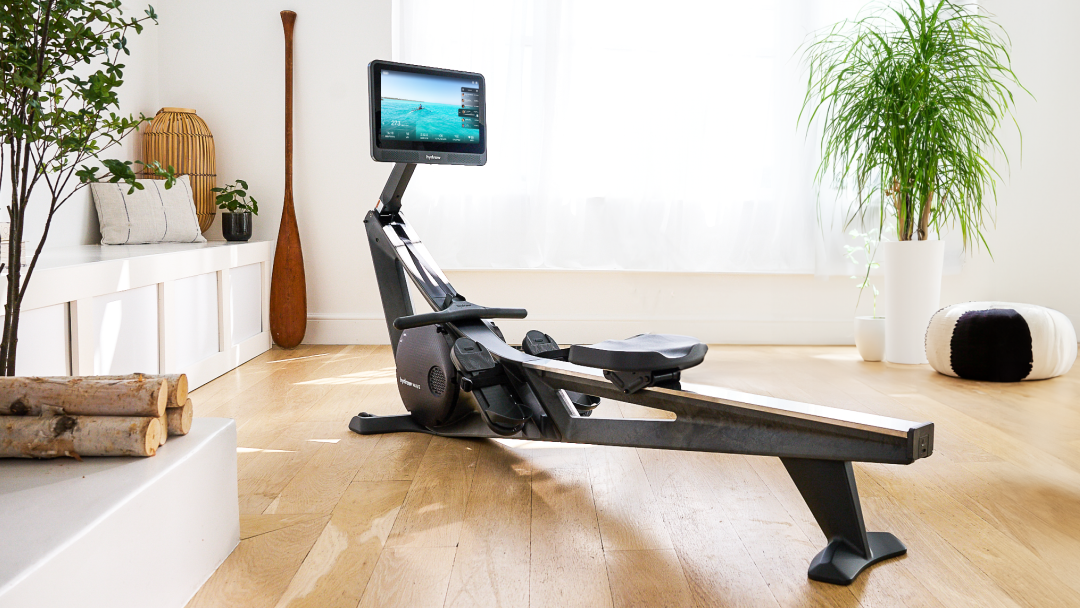
Real strength keeps moving
Learn how working out with Hydrow can help support a fuller, more active life.

